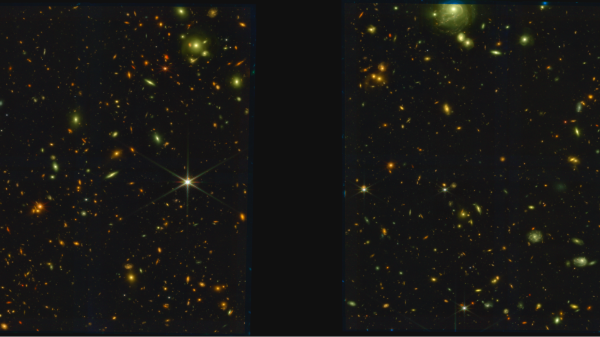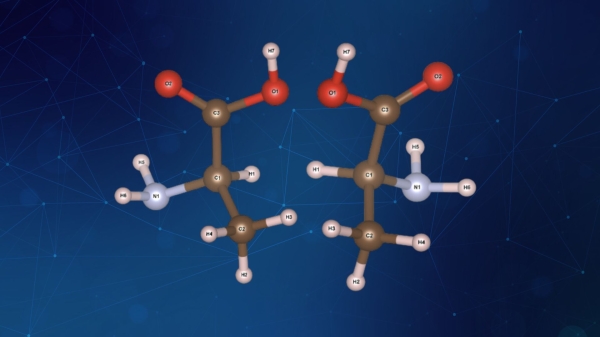When art meets science: Bringing Lucy to life

Paleoartist John Gurche touches up the Lucy re-creation. He spent the better part of a year making her look lifelike, doing research into the structure of not only of humans, but bonobos, chimpanzees, gorillas and orangutans. Photo by Steve Filmer/ASU
The challenge: Take just 40 small bones and conjure a life-size, lifelike recreation of one of the most important creatures in all of human history.
Arizona State University’s Institute of Human Origins put that challenge to paleoartist John Gurche. His answer now stands upright and peers out of a display window of a lab inside the Walton Center for Planetary Health on the Tempe campus.
Lucy is the name given to the fossil skeleton of an upright-walking human ancestor, Australopithecus afarensis. Some 60 days from now, ASU will mark the 50th anniversary of the day that the institute's founding director Donald Johanson found Lucy’s bones — estimated to be 3.2 million years old — in the remote desert of Hadar, Ethiopia.
Johanson’s discovery remains a pivotal moment in paleoanthropology. One reason is that her pelvis, spine and leg bones reveal that like us, Lucy was walking upright.
Gurche spent the better part of a year making her look — and hopefully, feel — alive. Lucy is the kind of work Gurche finds challenging but rewarding.
“I had a lot of work doing dinosaurs at first, but my real love was always human origins,” Gurche says.
It meant he had to hit the books, and the lab.
“So I began to work on dissections,” he says, “not only of humans, but bonobos, chimpanzees, gorillas and orangutans.”
That homework has spanned years and informs much of what can be seen in his reimagining of Lucy.
Lucy at 50 — a year of discovery
Throughout 2024, renowned paleoanthropologist and public scientist Donald Johanson and ASU's Institute of Human Origins have been celebrating the 50th anniversary of the discovery of the fossil skeleton Lucy.
By reflecting on the importance of that discovery, the institute aims to reignite a global interest in how we “became human,” promoting the importance of connecting our human past to the planet's global future.
Learn more at iho.asu.edu/Lucy50.
The final choices on several important features of his Lucy have been made with the guidance of Johanson and IHO Director Yohannes Haile-Selassie. One example is in the placement of Lucy’s big toes, which don’t appear with the kind of spread that chimps’ toes have, which helps them climb. The bones in the feet of Gurche’s Lucy line up more like the way our human foot bones do, which helps us to walk upright.
Perhaps the most striking feature on his rendering of Lucy is not at the bottom of her body, but at the top: Lucy’s face.
“I was looking for commonalities on the faces of great apes and humans,” Gurche says. “There are not many areas where things are identical in humans and great apes. In fact, I would say none. But there are relationships that hold for the entire group.”
Eyeball size is one example. Gurche has to make scientific details blend with what viewers see in his creation. Accuracy and artistry must work together.
“With the face, there has to be more there than just a mannequin,” he says. “You have to be able to connect with that face. You have to look into the eyes and feel that there’s a presence there. Otherwise, you might as well have not done the reconstruction. Because you’re trying to get across the point that this is a creature that actually lived and breathed and felt pain and joy and sorrow.”
Lucy can be seen inside the institute on the second floor of the Walton Center for Planetary Health, on the northeast corner of the Tempe campus. If you go to take a look, remember that Gurche’s intent is not just that you feel like you’re seeing Lucy. He’s also hoping that, on some level, you also feel that Lucy might just be seeing you.
View more of Gurche’s vivid re-creations on his website, gurche.com.
Spotlighting details of the discovery
This video is part of a monthly series on ASU News leading up the November anniversary of the Lucy discovery.
August: The tiny bone that led to a very big discovery.
September: When art meets science — bringing Lucy to life.
October: The crown jewel: Finding a complete skull for Lucy.
November: Donald Johanson on the momentous discovery and the future of related research.
More Science and technology

NASA-funded ASU study explores turbulence in molecular clouds
On an airplane, motions of air on both small and large scales contribute to turbulence, which may result in a bumpy flight. But turbulence on a much larger scale plays an important in how stars form…

'Robotic eyes' help researchers explore the Big Bang in reverse
Nearly 14 billion years ago, a mysterious energy sparked the Big Bang, causing the universe to expand rapidly and generating all known matter — a process described by the inflationary universe theory…

ASU researchers involved in scientific breakthrough unveiling method to distinguish 'mirror-image' molecules
An international team including researchers from Arizona State University and University of California, Los Angeles has made a significant breakthrough in molecular science, potentially transforming…